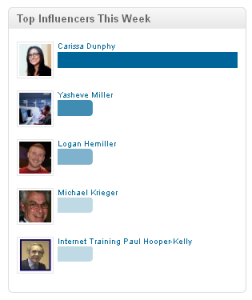 Through my own questioning, it seems like the majority of small businesses do not use LinkedIn because they either do not see it’s potential, don’t want to take the time to learn, or want to utilize LinkedIn, but taking the time to do so remains on the back burner.
Through my own questioning, it seems like the majority of small businesses do not use LinkedIn because they either do not see it’s potential, don’t want to take the time to learn, or want to utilize LinkedIn, but taking the time to do so remains on the back burner.
I myself get a lot of website traffic from LinkedIn when I share resourceful blog posts in relative groups. LinkedIn has also helped bridge networking connections with other entrepreneurs. Most of these connections started out by being added to someone’s network, which lead to a message, then a phone call and collaboration. LinkedIn is a different way to communicate, unlike Facebook, Twitter and Google+, and seems to be more effective when collaborating with other businesses.
With that said, sharing success stories from small businesses seemed to be like the next logical thing to do, with the hope that these stories may encourage more entrepreneurs to put some of their social media eggs in the LinkedIn basket.
LinkedIn has helped me generate over $10,000 in revenue for the company. Through LinkedIn, I’ve met approximately 20 business professionals in person, including business owners, managing partners of large law firms, and executives of well-known companies. Many of those meetings have led to referrals to Landmark Tax Group and the opportunity to serve clients that we wouldn’t have otherwise been able to reach.
Being actively engaged on LinkedIn has been extremely rewarding and the best thing about it from small business perspective is, it’s free.
Michael Raanan, LandmarkTaxGroup.com
As a fairly new business owner, LinkedIn has been incredibly valuable as a networking tool. InMail allows me to reach out to people in high-level positions and carries a lot more weight than an unsolicited email. Since you have to have a paid membership to send them, people don’t automatically assume they are spam. It’s been helpful in both reaching out directly to prospects, as well as expanding my network of valuable contacts.
Second, the search function allows me to get very granular as I comb through the members of the various groups I belong to. I can narrow down the list by geography, rank, position, company size, etc…and it allows me to target very specifically who I want to reach out to. It’s been quite valuable in identifying the individuals I want to connect with.
When you dig into the membership of groups, there’s gold to be found.
Jeffrey Hansen, NumusConsulting.com
Not a day goes by that I don’t use LinkedIn at least 10 times a day. I use it to find editors and media professionals who write about any number of topics. If they are wise, they have everything I would need to know about them on their LinkedIn page, including links to their writing samples and latest articles. I use it to suss out how seasoned a media or biz professional might be. If I’m reaching out to a writer, I can easily access their background, education, age (which helps if you are trying to find a decision maker. If they’re straight out of college, chances are they are not the decision makers at their business) and much more before I write to them. I love having all this information all in one place. I don’t know how “seasoned” a media professional is and how long they’ve been at a magazine just by looking them up on Cision.
I use LinkedIn to find like-minded businesses and business professionals. It is a one-stop-shop for all the contacts and info about people I needed and ultimately led me to a successful co-branded opportunity that will be happening very soon.
Andrea Burnett Public Relations, AndreaBurnett.com
I was an early adopter of LinkedIn but did not immediately adapt. Once I developed a strategy for what I wanted out of LinkedIn, I built my profile accordingly and started joining key groups. I have been able to leverage my group activity and my profile to generate both leads and consulting gigs.
The strategy is relatively simple: build a profile that reflects a defined area of expertise, then join groups related to that business niche. Once in the groups, be active in the form of posts that are germane: articles, blogs links and the like. These can be my own articles or blog posts or those of others, as long as they are germane. I monitor the activity of each discussion and participate as necessary, Participation AFTER posting is a major key to leveraging groups. Posting then not following or commenting indicates a lack of interest.
These actions have led to short and mid-term consulting and speaking gigs, and to people attending my seminars. They have also led to having a company bring me in to conduct my seminars in-house.
Mark Amtower, FederalNewsRadio.com
Are you using LinkedIn effectively and getting the most out of it? Please share you experiences with LinkedIn in the comments!




LinkedIn is a very popular media nowadays so it’s no surprise that it is now a helpful tool to drive traffic. I find it very professional and reliable too. Thanks for sharing this post. :)
While I am still working on it, I have found great B2B connections through LinkedIn. I make sure to post interesting and informative articles (my own as well as those written by others) in my groups. I also try to regularly comment on the posts of others. Because of this, I have had some connections turn into real business, and I anticipate this happening more!
LinkedIn is a very powerful networking tool. You can connect with businesses and various professionals, so it’s a great tool for prospecting. Using InMail to contact prospects is very worthwhile because LinkedIn promises a 30% response rate.